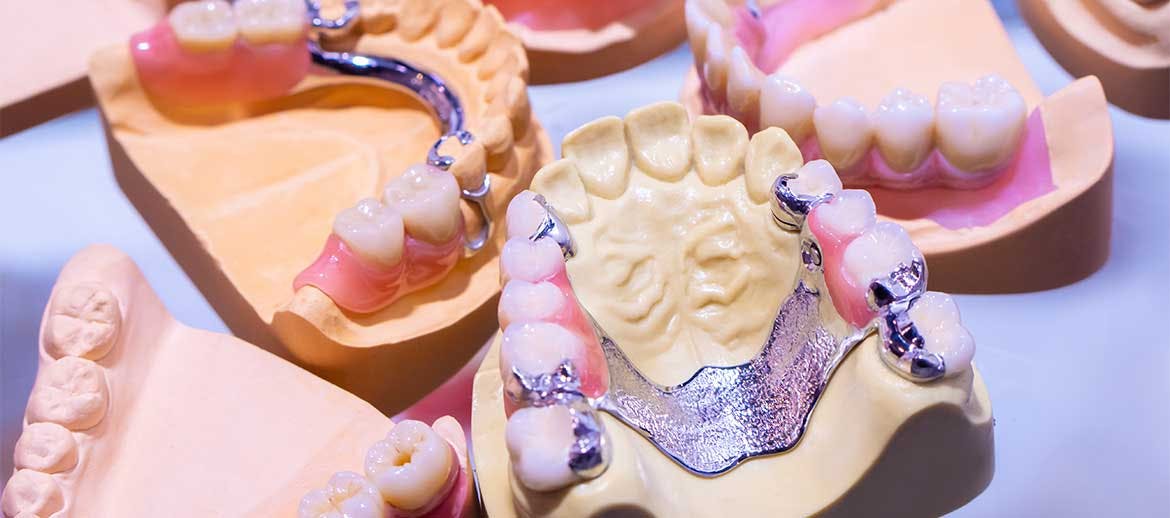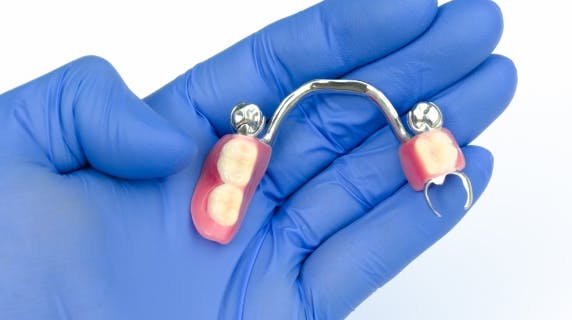Types of Partial Dentures
Partial dentures are a great solution for anyone missing some teeth but whose remaining teeth are otherwise healthy and sound. These devices are removable and fit over or around your remaining teeth—almost like a retainer or other orthodontic device—except you don't have to take partial dentures out to eat (and risk throwing it away like so many kids with retainers have over the decades). Instead, your partial dentures are designed to help you smile, bite and chew as you normally would. Learn more about the different types of partial dentures and how to find the right one for you.
What Are Partial Dentures?
A removable partial denture offers replacement teeth that can be put in and taken out of your mouth whenever you need.1 They help restore your smile and the function of your jaw by filling out the gaps caused by missing teeth.1 Partial dentures can be a great solution to missing teeth, and your dentist can help you determine which types of partials will work best for your needs.
Why Would I Need Partial Dentures?
Partial dentures can do more than fix your smile.2 A removable partial denture can help keep the structure of your jaw intact by filling in those gaps – and help restore your smile and confidence.1 What's more, partial dentures can also help improve the way you speak and eat by filling in gaps.1
What Do Partial Dentures Look Like?
Partial dentures have plates with one or more false teeth on them. They can be held together with plastic or metal, and they will have a way to attach to your other teeth. Partials generally attach to your remaining natural teeth using metal clasps or “precision attachments.”1 These connectors are attached to the teeth surrounding the partial denture, and they might be visible when you smile, depending on their placement.1
Clasps might require the nearby teeth to be crowned too, so that the clasp can be securely embedded in the crown.1 There are other ways to connect the partial denture to your teeth, including precision attachments, which might be a little less noticeable, but they can also be more expensive.
Partial Denture Designs & Materials
Removable partial dentures come in a variety of forms, and all of them are custom-made to suit your mouth. Here are some popular partial denture designs you can investigate:
- Light alloy dentures are made from a blend of light metal alloy and plastic and are colored to match your gums.2 They are more durable but light, which can help minimize irritation and discomfort when they are fitted by your dentist. Light alloy dentures cover less gum and soft tissue in the mouth, which helps to promote good oral health and can also help you to speak more naturally. Although this type of partial dentures tends to be more expensive, they are typically more durable than plastic partials.2
- Plastic partial dentures are a popular option, since they are less expensive than light allow dentures. They are constructed from injection molded and impact-resistant plastic that can give you increased comfort in your partials. Plastic partials also create a very natural and healthy-looking set of teeth.
- Flexible partial dentures are an option for some people who may find a light alloy or plastic removable partial denture difficult to use. Mouths are not uniform in shape, and flexible partial dentures solve this problem by adapting to the shape of your remaining teeth and gum tissue. This type of partial dentures often don’t even require clasps to hold them in place. Flexible partials are made from transparent materials that blend in easily with the natural color of your mouth and gums – and they’re often faster to make than plastic and light alloy dentures.
The main differences between the different types of partials are the materials that they're made of. Your partial dentures will be custom-fitted to your mouth, so don't be concerned if they don’t end up looking exactly like the examples you've seen online or at the dentist. The important thing is that they fit comfortably and securely, so that you can live your life.
How Long Does it Take to Create Partial Dentures?
Depending on the type of removable partial denture required, it can take time to make and fit a partial denture. The timeframe will be unique to each person. On your initial visit, your dentist will take molds and measurements of your mouth so that your partial denture can be custom fit to you. Once the partial denture has been modeled and made, it may require more visits to adjust it, as bones and gums can shrink over time and may affect the partial denture fit.
How Much Do Partial Dentures Cost?
Costs can vary widely based on the type of partial, the location in your mouth and your provider. Average costs can be anywhere from $300 to around $1,800. Your dentist will be able to advise on pricing and the level of follow-up care.
Your insurance may be able to cover the costs of your partials, but this will mainly depend on the insurance policy. For more information about denture insurance coverage, contact your insurance provider before starting the process.
How to Maintain Partial Dentures
The American Dental Association, along with the American College of Prosthodontists, recommends removing and cleansing your dentures and brushing them with a soft toothbrush at least once a day.3 Your natural teeth should be cared for as directed by your dental professional. Avoid using an abrasive toothpaste for both partials and instead use a gentle, non-abrasive cleanser, such as Polident for your partials. Make sure you use this as directed.
Cleaning your partials daily with a denture cleanser such as Polident 3-Minute Denture Cleanser will help lift stains and kill odor-causing bacteria. Be sure to rinse thoroughly and dry your partial denture before putting it back in your mouth.
In many instances, removable partial dentures are a straightforward and good-value solution to the problem of missing teeth. With care and maintenance – and regular visits to the dentist – they can last for several years. While they can take some getting used to, partial dentures help keep gums, teeth, jawbone and facial muscles working as they should to give you the confidence of a natural smile.
Learn more about maintaining a healthy mouth with our oral health care tips for partials.
Source Citations:
- Dentures Partial. American Dental Association. https://www.mouthhealthy.org/all-topics-a-z/dentures-partial/. Accessed 9/8/2023.
- Bridges and Partial Dentures. Oral Health Foundation. https://www.dentalhealth.org/bridges-and-partial-dentures/. Accessed 9/8/2023.
- Denture Care and Maintenance. American Dental Association. https://www.ada.org/en/resources/research/science-and-research-institute/oral-health-topics/dentures/. Accessed 9/8/2023.





